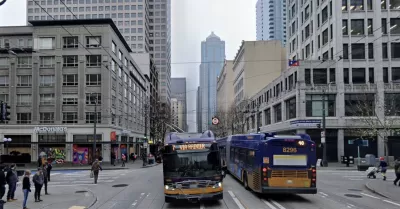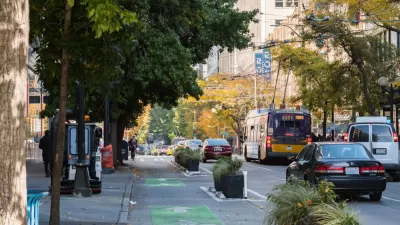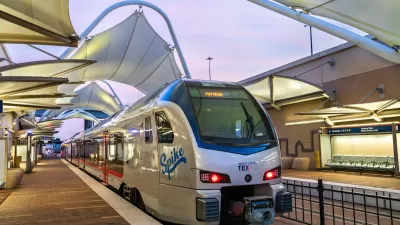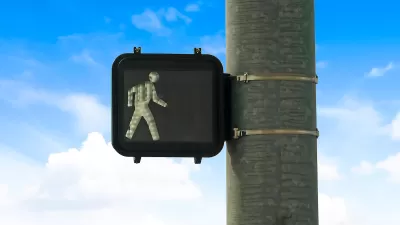The editorial board of The Urbanist lays out their plan for a reimagined Third Avenue that plays to the strengths of the corridor while improving safety and transit service.

The Urbanist’s editorial board speaks out in favor of a bold and actionable plan for Seattle’s Third Avenue, one of the busiest transit corridors in the country but “a place where many a plan goes to die.”
At The Urbanist, we believe the Third Avenue plan must focus on improving transit service and pedestrian safety. Some sections have great opportunities for street art, pocket parks, and sidewalk cafes. If we make the street more walkable and the bus stops pleasant, safe, and busy, then street life will follow.
The board writes that the plan “should also recognize and promote the unique strengths and needs along each of the distinct sections of the street,” and recommends treating each of the street’s four segments separately, using street design to enhance each neighborhood’s existing assets.
The board also calls on the city to invest in ways to help people facing mental health and substance abuse crises, citing the rise of mental health issues and opioid use during the pandemic, which, in addition to harming users, has also led to an increasingly negative public perception of Third Avenue and, more broadly, the city’s public transit.
According to the board, “Policymakers must acknowledge that Third Avenue is going to continue to be a transit workhorse, but it can be walkable and loaded with street activation, too.” Cautioning against more lofty but unattainable plans, the board writes, “But what we need isn’t another big dreamy visioning exercise that goes nowhere or settles on a small incremental change. There are actions and investments that could be made that would produce real results.”
FULL STORY: An Urbanist Vision for Seattle’s Third Avenue

Planetizen Federal Action Tracker
A weekly monitor of how Trump’s orders and actions are impacting planners and planning in America.

Congressman Proposes Bill to Rename DC Metro “Trump Train”
The Make Autorail Great Again Act would withhold federal funding to the system until the Washington Metropolitan Area Transit Authority (WMATA), rebrands as the Washington Metropolitan Authority for Greater Access (WMAGA).

The Simple Legislative Tool Transforming Vacant Downtowns
In California, Michigan and Georgia, an easy win is bringing dollars — and delight — back to city centers.

The States Losing Rural Delivery Rooms at an Alarming Pace
In some states, as few as 9% of rural hospitals still deliver babies. As a result, rising pre-term births, no adequate pre-term care and "harrowing" close calls are a growing reality.

The Small South Asian Republic Going all in on EVs
Thanks to one simple policy change less than five years ago, 65% of new cars in this Himalayan country are now electric.

DC Backpedals on Bike Lane Protection, Swaps Barriers for Paint
Citing aesthetic concerns, the city is removing the concrete barriers and flexposts that once separated Arizona Avenue cyclists from motor vehicles.
Urban Design for Planners 1: Software Tools
This six-course series explores essential urban design concepts using open source software and equips planners with the tools they need to participate fully in the urban design process.
Planning for Universal Design
Learn the tools for implementing Universal Design in planning regulations.
Smith Gee Studio
City of Charlotte
City of Camden Redevelopment Agency
City of Astoria
Transportation Research & Education Center (TREC) at Portland State University
US High Speed Rail Association
City of Camden Redevelopment Agency
Municipality of Princeton (NJ)





























